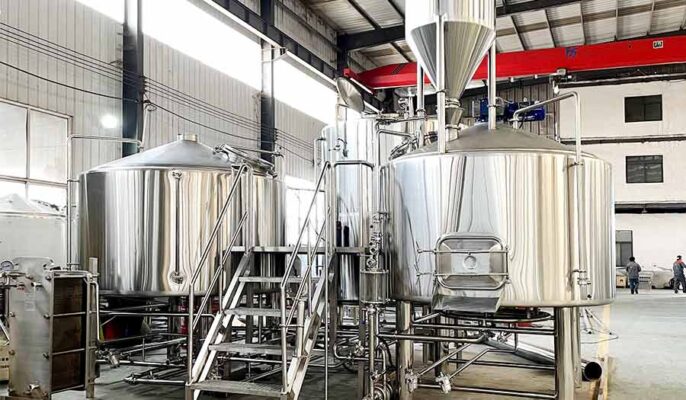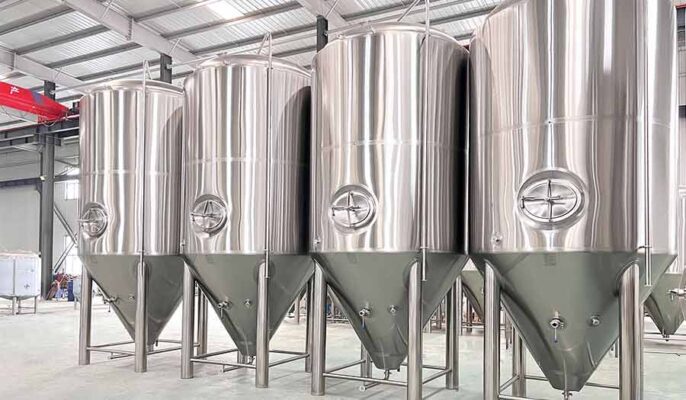As the craft beer industry continues to boom, there is an increasing demand for high-quality, efficient, and optimal commercial brewing system equipment. Commercial brewing equipment is the backbone of any brewery, determining the quality, consistency, and efficiency of beer production. Micet’s commercial brewing solutions, from individual components and process modules to turnkey projects, are designed and manufactured to provide tight control over your brew while giving you the flexibility to help brew exceptional beer.
What is a commercial brewing system?
Commercial brewing systems are specialized equipment designed for the large-scale production of beer and other fermented beverages. These systems vary in size and complexity, from small units used in craft breweries to large commercial configurations. From brewpubs and microbreweries to craft breweries and large industrial facilities, institutions rely on these systems to meet the needs of beer drinkers around the world.
Types of Commercial Brewing Systems
- Brewpub system: The Brewpub system is a compact brewing device used in restaurant or bar venues. They allow these establishments to offer their brews on tap, adding a unique touch to their culinary experience.
- Microbrewery Systems: Microbrewery systems are small installations but have a wider range of features than beer bar systems. They are breweries that specialize in craft beer for sale to the local market.
- Craft beer systems: Craft brewery systems are medium-sized equipment suitable for producing large quantities of beer and distributing it across regions or states. They keep the essence of craft beer while catering to a wider audience.
- Industrial brewery systems: Industrial brewery systems are large-scale operations with significant production capabilities. These breweries serve beer and even , making them major players in the beer industry.

Basic components of commercial brewing system equipment
Milling equipment
Before any brewing can take place, the grains used in the brewing process need to be ground into a fine powder. Grinding equipment grinds grains to create a consistent size and texture for optimal brewing. Milling equipment varies in size and capacity, with some mills capable of processing more than 10,000 pounds of grain per hour.
Brewery equipment
Brewery equipment is at the heart of the brewing process. It consists of various components that work together to convert wort into wort. The process begins by mixing malt flour with water in a hydrator in the mash tun. After a set time, the mixture is transferred to the lauter barrel, where it is separated into liquid wort and spent grains. The wort is then boiled in a brewing kettle and hops and other ingredients are added at specific times to achieve the desired flavor profile.
Brewery basic components:
- Mash Tun: used to convert starch into sugar.
- Boil the kettle: Boil the wort with hops.
- Fermentor: Yeast converts sugar into alcohol.
- Filtration system: for clarity and purity.
- Packaging: Bottling, canning, and barreling equipment.
Commercial breweries use equipment customized to their required capacity:
|
PARAMETER |
TYPICAL RANGE |
|
Annual beer production capacity |
1,000 – 10+ million barrels |
|
Mash filter capacity |
500 – 10,000 kg/batch |
|
Brew kettle size |
500 to 5,000 barrel batches |
|
Fermentation tank size |
100 to 3,000 barrels each |
|
Bright beer tank size |
500 to 5,000 barrels each |
Mash tun
The mash tun is another important piece of equipment for commercial brewing. The mash tun has temperature control and allows you to mix the grains with water to produce the desired mash. The mash tun also heats the mixture, which helps break down the starches in the grains and convert them into the sugars needed to make the beer alcoholic.
Fermentation equipment
Once the wort is ready, it is transferred to a fermenter where yeast is added. Fermenters are designed to control the temperature, pressure, and oxygen levels of the beer during fermentation. Water tanks are made of stainless steel and range in size from a few hundred to several thousand gallons. Commercial breweries need quite a few breweries, and they need to be larger to accommodate the large volumes of beer you want to produce. This is where you add yeast and turn the wort into real beer. Fermenters are controlled environments that help yeast convert sugar into alcohol.
Brit tank
Once fermentation is complete, you’ll need a place to store it. For smaller operations, you can store your beer in a fermentation tank. But, commercial breweries need to immediately release these fermenters to produce new batches of beer so the beer can be transferred to beer tanks for storage. Brite tanks are not for storage, though, as the environment in a Brite tank helps ferment beer carbonate faster so it can be packaged and consumed more .
Filtration equipment
After fermentation, the beer is transferred to conditioning tanks for aging and clarification. Beer is aged for some time, allowing the flavors to develop and mature. During this process, any remaining yeast or sediment settles to the bottom of the tank, resulting in a clear, crisp beer. While not all these substances are inedible or will spoil the product, if not removed early, they may affect the taste in ways you don’t want or cause the product to spoil faster.
Packaging Equipment
After the beer has been conditioned, it is ready for packaging. Packaging equipment includes filling machines, canning machines, and barreling equipment. These machines fill, cap, label, and seal containers, preparing them for shipping and distribution.
Cleaning tools
Hygiene is an important aspect of brewing beer. Without proper cleaning, bacteria and other contaminants can ruin a batch of beer. Cleaning equipment such as CIP tanks, hoses, and pumps is necessary to ensure that all brewing equipment is cleaned and sanitized before and after each use. Cleanliness and sanitation are critical to the success of a brewery. Whether we’re talking about an automated keg cleaning system or using the right chemicals to keep your tanks clean, you can’t skip the cleaning step of brewing.

The brewing process of commercial beer brewing
- Malting: The brewing process begins with malting, where grains such as barley are soaked in water and allowed to germinate. The malted grains are then dried in a kiln to produce malt, which is the basis of beer’s flavor.
- Mashing: In the mashing barrel, malt is mixed with hot water to form a viscous mixture called “mash”. During this process, enzymes break down starch into fermentable sugars, producing wort.
- Boiling: The wort is transferred to the brewing pot where it is boiled. Hops are added at this stage to impart bitterness, aroma, and flavor to the beer.
- Fermentation: After boiling, the wort is cooled and transferred to the fermentation tank. Yeast is added to start the fermentation process, in which sugar is converted into alcohol and carbon dioxide.
- Conditioning: After fermentation is completed, the beer will enter the conditioning stage to mature and develop its flavor.
- Packaging: Finally, the beer is filtered, carbonated, and packaged into bottles, cans, or kegs for distribution and consumption.
Commercial Brewing System Equipment Maintenance and Care
- Regular cleaning and disinfection: Proper cleaning and disinfection are essential to prevent contamination and ensure beer quality. Daily cleaning schedules and use of food-grade disinfectants are standard practice.
- Preventive maintenance practices: Regular maintenance can extend the life of your brewing equipment. Lubrication, seal replacement, and inspection are critical to identifying and solving potential problems before they escalate.
- Troubleshooting common problems: Even with the best equipment, problems can arise. Brewers should be proficient in solving common problems to cut downtime and maintain production flow.
Commercial Brewing System Installation
- Site and facility preparation: Choosing a suitable location and preparing the facility to house the brewing system is critical.
- Equipment delivery and assembly: Ensure smooth delivery and assembly of brewing equipment to avoid delays.
- Utility connections: Proper connections to water, electricity, and steam supplies are critical to the functionality of the system.
- Testing and Commissioning: test and debug the system to ensure everything is running .
How to choose commercial brewing system equipment?
- Determine your size: Before delving into the technical details, determine the size of your brew. Are you a home brewery, a small brewery, or a commercial-scale brewery? Your scale will determine system size, capabilities, and budget.
- Decide on the level of automation: Some brewers prefer manual control and enjoy the hands-on nature of brewing, while others favor automated systems for increased efficiency and consistency. Determine where you stand on this spectrum and choose a system .
- Budget: As with any major investment, budget plays a vital role. While it’s important to stay within financial limits, remember that quality often comes at a price. Weigh the system’s features against its cost to ensure you get the best value for your money.
- Future expansion: Even if you’re starting small, think ahead. If you plan to expand in the foreseeable future, choose a system that can be expanded . Modular systems allow capacity to be added without a complete overhaul, making them a smart choice.
- Consider technical support: Brewing systems, especially advanced brewing systems, can have a steep learning curve. Choose a brand that offers strong technical support, whether through detailed manuals, a helpline, or on-site training.




